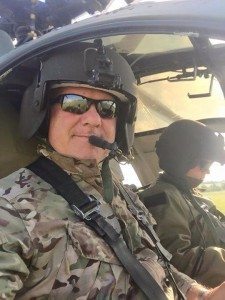
Engaging a target from a helicopter is one of the most unique and exhilarating manners of firing a rifle. The skill has been employed and refined by the special operations community. Like many other military skills and approaches, law enforcement and even hunters are trying to translate those lessons learned to the civilian sector.
Greg Coker is a 20 plus year veteran who spent the overwhelming majority of his service in the Special Operations Aviation Regimen. He flew over 5,000 hours in the AH-6 Little Bird helicopters at the edge of their performance envelope. As a firearms instructor he’s also a leading (if not “THE” leading) proponent for training Helicopter Aerial Rifle Marksmanship (HARM). He offers that realistic top notch training through his company, Shield 91. HARM is often employed to provide over watch of a high value target, stopping large trucks, engaging drivers of lone vehicles, operations in open terrain, vehicle interdiction, active shooters, VIP security and personnel/armed suspects fleeing a target/crime area. This technique keeps from exposing ground personnel to the threat and also minimizes collateral damage with precision fires.
Shield 91’s HARM training consists of classroom/ground instruction and live aerial firing with the goal of developing a helicopter-weapon- pilot-shooter-crew team dynamic. Greg Coker emphasizes no single or even multiple components can achieve success. Engaging targets from the air requires coordination and planning between all the players before and during the flight with an understanding of the machines’ capabilities before and while using them.
Classroom/ground instruction is kept to a minimum but covers a myriad of subjects like detailed flight profiles, the ballistics and physics that govern shooting from an aircraft in flight, various ways to configure a helicopter as a shooting platform and of course safety procedures. Students receive Coker’s proprietary ballistics table and participate in discussions on how to engage a stationary target from a moving helicopter which entails “lagging” the target. The table provides information on how to “lag” a target based on range and helicopter airspeed.
The real fun begins as Coker puts students through the practical portion of his one or two day course. Students fire about 300 rounds per day. The initial goal is training to a three shot standard with parallel, known distance targets. This is where the basics of lag aiming and lag-offset estimation are practically taught. By the end of the daylight portion of the first day students can engage a man sized point target to a three shot standard at speeds of at least 40 knots at an altitude of 100 feet and 100 meters offset from target. Eventually, each student progresses to 60 knots, and 200 – 300 meter offsets.
Should the client require the capability to engage at night this is where the evening portion of day one is focused. Night engagements repeat the day drills in a compressed format. Most shooters who take this portion of the course are experienced in using night vision goggles. Night engagements familiarize students with low light offset-aim point acquisition.

Students that take the two day course focus on angled target presentation on the second day. The difficulty is raised by including random targets. Angled targets require modified aim point-offsets for targets presented at less than 90 degrees. Targets of less than 90 degrees from the direction of flight of a helicopter are deceptively difficult. Range to the target changes differently at angles under 90 degrees and must be accounted for by the shooter. Special attention is given to techniques used to engage in this type of situation. Random target engagement is the final drill. The drill’s intent is to add an additional level of stress to the engagement process. Compressing engagement times and randomly altering target distance provide the additional stress. The three shot standard still applies to both increased angles and random target drills. Coker states that these techniques keep from exposing ground personnel to threats and also minimizes collateral damage with precision firing.
Greg Coker recommends the M4 platform for HARM. Its high magazine capacity and low recoil are ideally suited to execute difficult aerial engagements where quick follow up shots are normally required. The 5.56 round also presents a smaller risk of ricocheting or over penetrating a target. This is a key concern since shooters are always responsible for every shot they take. Considering the current environment this applies even more so to law enforcement. Additionally, Coker recommends a non-magnified red dot optic so the shooter can index the target properly with both eyes open. Sound application of all the shooting fundamentals e.g. sight picture, stable position, trigger control and proper breathing go without saying and engagements are conducted in the semi-auto mode only. A sling and a stash of bungee cords will come in handy for rigging a stable platform to shoot from the helicopter.
It is best that students take the course with the aviation section they will be working with to practice under Greg’s auspices to learn together how to develop the coordination, communication and teamwork necessary to successfully engage from a moving helicopter. HARM is not precision marksmanship. Students eventually demonstrate the capability to place a high percentage of their shots within a few feet of a target. Practically, this tool applies to situations where the target is not in a crowd or obscured by a hostage.
HARM addresses the capability gap where a need for Aerial Marksmanship and a helicopter coincide. It simultaneously provides an excellent aerial platform for aircrews and shooters to engage point targets and provide the employing organization with information to enhance operations and safety. Whether you are an Operator that is tasked to ride a plank, a designated marksman in the aircraft, an Aircrew member or a hunter culling a herd or doing predator control HARM provides a singular capability in a short period of training time.
